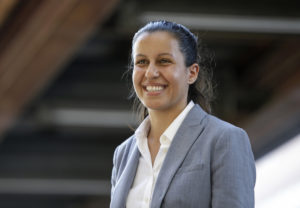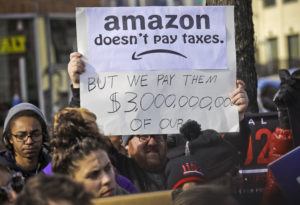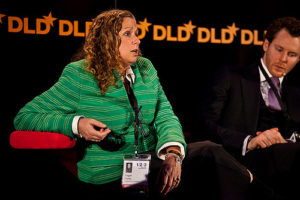Gay Marriage: From Stonewall to Albany
New York’s action last week signifies more than just one more state added to the list of those permitting same-sex marriage.
Twoscore and two years ago an urban riot in New York’s Greenwich village became the symbol of a new movement for liberation [see accompanying article on Stonewall], so it is fitting that crowds gathered at the site of the Stonewall Inn to celebrate Friday’s historic vote by which New York became the largest state to legislatively approve marriage equality for lesbian and gay citizens.
The struggle for GLBT rights did not begin at Stonewall — that honor, if it is to be awarded to a particular place and particular persons, probably goes to a small gathering of leftist gay men in Los Angeles who founded the Mattachine Society in 1950 — but symbols are important, and just as Stonewall became the embodiment of militant queer activism, so too New York’s action last week signifies more than just one more state added to the list of those permitting same-sex marriage.
|
Homo Nest Raided, Queen Bees Stinging Mad Among the many landmarks of the turbulent decade of the 1960s, few have achieved the fame and symbolic resonance of events that began as a fairly routine example of police harassment on a hot June night in 1969. Police raids on gay bars were neither new nor unusual, though they had become less frequent by the late 1960s. When the police raided the Stonewall bar in Greenwich Village on June 28 they did not expect to set off a riot—and they certainly did not expect to ignite the explosion of a militant gay rights movement. But when many bar patrons, soon joined by allies on the streets, fought back, the incident sparked several nights of rioting—and the Stonewall riots set off a flurry of organizing that soon turned into a firestorm of activism across the country. … |
One of the essential accomplishments of the early pre-Stonewall liberation movement was to change the self-definition of gay people, from that of individuals who deviated from society’s expectations — because they were mentally ill, immoral or criminal — to that of members of a minority group which constituted a community dispersed throughout heterosexual society and largely invisible to outsiders.
The first full-scale polemic for equality, Donald Webster Cory’s “The Homosexual in America: A Subjective Approach,” was published in 1951. Cory presented a forceful argument that homosexuals constitute a minority within American society: “Our minority status is similar, in a variety of respects, to that of national, religious and other ethnic groups: in the denial of civil liberties; in the legal, extra-legal and quasi-legal discrimination; in the assignment of an inferior social position; in the exclusion from the mainstream of life and culture.”
In a 1963 follow-up book, “The Homosexual and His Society: A View From Within,” written with John LeRoy, Cory restated his thesis “that the invert is a member of a minority group, differing from ethnic and other minorities essentially in that his status as a minority group is unrecognized,” and celebrated the “feeling of group recognition [that] has grown among these people,” leading to the launching “of a struggle for the rights guaranteed to all citizens of a free democratic society.” Describing the beginnings of that movement in “small secret underground groups,” Cory and LeRoy note, “With diminishing secrecy, several distinct groups and societies have found their way on the American scene, fighting a legal, social and political battle in order to help win public acceptance for the invert and his way of life.”
By the early 1960s, movement leaders emerged who were inspired by the civil rights movement to proclaim that “gay is good!” They began taking their struggle to the streets, demonstrating in front of government buildings and demanding an end to laws that criminalized gay people and promoted discrimination and harassment. The gay liberation movement in the Stonewall era was a child of its times, inspired by the civil rights, the anti-war and women’s movements, and it shared a belief in the possibility of radical social transformation. Gay liberation was seen as part of the full spectrum of radical social change that the period celebrated, challenging and overturning conventional norms and expectations. Like these other movements, it was also largely a movement of young people, less invested in the status quo and more willing and able to take risks. And risky it was, as homosexual acts were illegal in all but one state, and gay people could be fired or denied housing or access to public accommodation without any legal recourse. Thus, among the first goals of the liberation movement was the achievement of basic civil rights; here, too, the analogy to the civil rights movement and the recently passed Civil Rights Act was explicit.
The movement that burst into flames across the country after the Stonewall riots followed in the model of all American minority movements by building its strength in big cities, where the concentration of numbers could translate into voting blocs and financial support for friendly politicians. Eventually, as in the election of Harvey Milk — one of the first openly gay elected officials in the country — to the San Francisco Board of Supervisors, concentrated political power in big cities resulted in the enactment of city ordinances prohibiting discrimination on the basis of sexual orientation.
The early successes of the gay movement were quick to bring a reaction from a religious right that was newly energized as a political force after the 1973 Roe v. Wade decision. In 1977 orange juice spokesperson and former Miss America second runner-up Anita Bryant led a campaign to repeal an anti-discrimination ordinance in Florida’s Dade County. The campaign, under the name Save Our Children (as Bryant put it, “They [homosexuals] can’t reproduce, so they have to recruit”), was successful, and set the tone for similar fights across the country.
In California, state Sen. John Briggs failed in an attempt to outlaw homosexual teachers, in part because labor joined forces with gay activists to defeat the measure. Even former Gov. Ronald Reagan opposed Brigg’s Proposition 6. But the lines were soon to be drawn more starkly, as the Republican Party soon cemented an alliance with the religious right that put anti-gay policies, along with opposition to reproductive rights, at the center of its social agenda.
|
Related interview from Truthdig Radio: |
Through the 1980s and into the 1990s the religious right wing of the Republican Party fought to repeal the gains of the GLBT movement, labeling them as “special rights” rather than basic civil rights. At the same time, the Democrats, always fearful of being accused of capitulating to “special interests” such as minorities and women, did as little as they could get away with, while still raising money from gay people. After all, the argument always went, the political alternative to the Democrats was worse.
In 1992 an amendment was passed in Colorado that outlawed local anti-discrimination ordinances protecting gay citizens. This was challenged in state courts and ultimately in the U.S. Supreme Court, where the Romer v. Evans decision was the first important victory for GLBT rights in the highest court. This was followed ultimately in 2003 by the landmark Lawrence v. Texas decision (written, like Romer v. Evans, by Justice Anthony Kennedy), which abolished all “sodomy laws” and reversed the odious 1986 Bowers v. Hardwick, which upheld laws criminalizing homosexual acts.
By the early 1990s, the stage was set for campaigns to open some of the most central precincts of society to openly gay people. The 1992 Republican National Convention had been seen by many as excessive in its hostility to gay people, and the election of Bill Clinton as president was seen as heralding a new era of social progress. The GLBT movement pressed its apparent advantage, demanding that gay men and gay women be allowed to serve openly in the military. But GLBT folk, like other progressive groups, were soon to learn how shallow President Clinton’s commitment was, and how weak his resolve in the face of opposition. Thus we entered into the nearly two decades of the farcical and destructive “don’t ask, don’t tell” policy.
The question of same-sex marriage was raised almost at the start of the post-Stonewall era, in 1970, when two Minnesota law students, Richard Baker and James McConnell, applied for a marriage license. They appealed the denial of the license and their appeal went all the way to the U.S. Supreme Court, which refused to hear the case. This case received little attention, and while the issue of marriage equality surfaced from time to time in the next two decades, it was never on the front burner of the movement or the public agenda. Things changed, however, in 1993, on the heels of the “gays in the military” fracas, when the Hawaii Supreme Court ruled that the legislature needed to show why same-sex marriage should not be permitted under the state constitution. This decision, presumptively approving same-sex marriage, set off a political and legal struggle. In 1998 a constitutional amendment outlawing same-sex marriage in Hawaii was passed by voters after a campaign heavily financed by the Mormon Church.
The Hawaii decision ignited a fire storm on the religious right, as the issue was ideally designed to alarm its constituents. In the next few years, state after state passed constitutional amendments and referendums outlawing same-sex marriage. Referendums against same-sex marriage proved to be a valuable political organizing tool, bringing out the conservative vote in election after election, as the technique spread across the country.
In 1996, at a time when no state permitted same-sex marriage, Republicans in Congress proposed the Defense of Marriage Act (DOMA). This act, passed that same year, enshrines opposition to same-sex marriage in federal law, prohibits the federal government from recognizing such marriages and, in effect, suspends the Constitution’s “full faith and credit” clause that would require states to recognize marriages enacted in other states. Although possibly intended to trap the Democrats in the 1996 elections, the bill passed by a large bipartisan majority and was signed by President Clinton, who made it clear that he did not support marriage equality.
George W. Bush’s presidential victory in 2000 did not put an end to GOP enthusiasm for proposing measures against same-sex marriage, especially as Republicans noted that a lack of political zeal on the religious right had contributed to Bush’s popular vote loss to Al Gore. In 2004, as part of an effort to arouse the party’s religious-right base, the Republican platform included a call for a constitutional amendment outlawing same-sex marriage. At the same time, similar amendments were on the ballot in 11 states (Arkansas, Georgia, Kentucky, Michigan, Mississippi, Montana, North Dakota, Ohio, Oklahoma, Oregon and Utah), and all passed.
However, there was progress on the marriage equality front, notably the enactment of same-sex marriage in Massachusetts in 2004, followed by Connecticut, Iowa, New Hampshire, Vermont and Washington, D.C. Same-sex marriage was enacted in California in June 2008 but repealed by Proposition 8 that November. A similar pattern occurred in Maine in 2009.
On the legal front, a challenge to California’s Proposition 8 was successful in federal court and the case was expected to go to the Supreme Court, but its progress has been stalled because neither the governor nor the attorney general is willing to defend Prop. 8 in the courts.
In 1996, then Illinois state Sen. Barack Obama answered a question from a Chicago gay paper, writing that “I favor legalizing same-sex marriages, and would fight efforts to prohibit such marriages.” Twelve years later, however, presidential candidate Obama, speaking at conservative evangelist Rick Warren’s Southern California church, said, “I believe that marriage is the union between a man and a woman. For me as a Christian, it is a sacred union. You know, God is in the mix.” Since his election, Obama has played a game all too familiar to minorities dealing with the Democratic Party. Like Clinton before him, Obama claims to be a supporter of GLBT rights — a “fierce advocate” is the term he has used — especially when he is seeking to raise money from gay people, but he has offered platitudes rather than action on key issues. In some ways the Obama administration has done more than most for GLBT folks, but it has measured out its efforts in small doses, treated minor changes as major accomplishments and refused to confront the central moral issues head on.
The biggest achievement under this administration, the repeal of “don’t ask, don’t tell,” was pushed through only after gay activists raised the ante by acts of widely publicized civil disobedience; and implementation of the repeal is still not under way.
Simply put, if one is committed to fundamental equality, and to the constitutional separation of church and state, then there is no basis for perpetuating inequality in marriage, military service or any other domain of the public sphere. Full legal equality should not require everyone to make the same choices — whether to marry, join the military, or any other life decision — but it does mean that everyone should be free to make such choices if they wish.
President Obama says that his position on marriage equality is “evolving” — although given his 1996 statement it might be said to have devolved — and it is not entirely cynical to imagine that this evolutionary process might reach a conclusion sometime after the 2012 election. After all, former President Clinton, whose wife may still harbor presidential ambitions, now says that he favors same-sex marriage.
While Bill Clinton’s newfound support for marriage equality may be relevant to a future Hillary campaign or perhaps to his own final, unannounced campaign for the Nobel Peace Prize, there are real stakes involved for American rights.
New York’s action last week is an important step in the struggle for marriage equality, as New York is by far the biggest and more important state to achieve this through legislative action, and it suggests that politicians are reading the tea leaves in a new light. Recent nationwide polls show a slender public majority now favoring marriage equality, and this may have contributed to the decision by a few Republicans to vote for the bill in Albany. But more important than the simple poll numbers are the demographic details. This is an issue whose outcome can be read in the breakdowns by age. According to a recent Pew Research study, voters who are 65 or older oppose gay marriage by a 58-24 margin, but voters who are between 18 and 29 support gay marriage by a 52-40 margin.
The next, and crucial, stage in the fight for marriage equality is the repeal of the odious Defense of Marriage Act, which stands as a barrier against the realization of the gains made so far in achieving marriage rights in a handful of states. The most important legal consequences — and benefits — conferred by marriage are those enshrined in federal law. The General Accounting Office issued a report in 1997 identifying 1,049 federal statutory provisions in which benefits, rights and privileges are contingent on marital status or in which marital status is a factor. The Obama administration has declared that DOMA is unconstitutional and that it will not defend the act in court; Republican Speaker John Boehner responded by saying the House would hire a lawyer to do so. However, Obama has not made repeal of DOMA a priority and there has been no coordinated effort to do so, even while the Democrats controlled both houses of Congress.
Marriage equality is only one of the important arenas in the fight for full equality. Despite years of effort, only 20 states and the District of Columbia offer legal protection against discrimination on the grounds of sexual orientation (or, in 12 of these states and D.C., gender identity). Various incarnations of federal non-discrimination legislation have been launched but none have yet succeeded in passing either house of Congress. The simplest and most effective step, of course, would be the simple addition of sexual orientation and gender identity to the protected categories listed under the U.S. Civil Rights Act, but neither party has advocated so obvious a measure.
The tide of history, and demography, is on the side of equality for gay folks. The Republican Party seems to be staking its strategy on intransigence and catering to the right.
Obama, here as elsewhere, is unwilling to demonstrate moral leadership. Speaking in New York at a GLBT fundraiser the day before the New York Legislature voted, he took a “states rights” position on this civil rights issue: “Traditionally marriage has been decided by the states and right now I understand there’s a little debate going on here in New York,” he said to laughter. New York’s lawmakers, he said, are “doing exactly what democracies are supposed to do.” The president, however, was not doing what leaders are supposed to do. Within 24 hours of the dinner at which Obama spoke, Albany legislators, including several Republicans, demonstrated more moral integrity than the president of the United States. The question remains whether, and when, he will catch up.
Larry Gross is the director of USC’s Annenberg School for Communication, one of the founders of queer studies and a scholar of art, media, and the portrayal of minorities.
Your support matters…Independent journalism is under threat and overshadowed by heavily funded mainstream media.
You can help level the playing field. Become a member.
Your tax-deductible contribution keeps us digging beneath the headlines to give you thought-provoking, investigative reporting and analysis that unearths what's really happening- without compromise.
Give today to support our courageous, independent journalists.




You need to be a supporter to comment.
There are currently no responses to this article.
Be the first to respond.